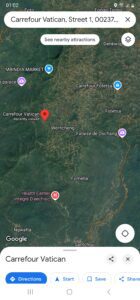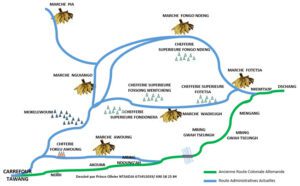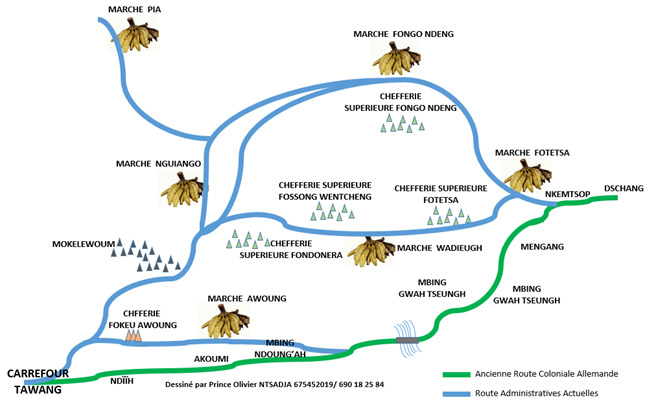F4 Corridor Proposal
The Importance of Avoiding Dschang Cliff in Regional Connectivity
Join the discussion on the F4 Corridor Proposal, which aims to create a second Dschang-Santchou axis in Cameroon. Share your insights with Vatican Group Association (VGA) and tag #secondaxedschangsantchoupassantparf4 #Corridorf4 . The Dschang cliff in the Menoua department of Cameroon, a notable geological formation in the region, poses significant challenges to transportation and connectivity. The steep and rugged terrain of the cliff makes it difficult for vehicles to traverse, leading to frequent accidents and delays. This has a direct impact on the flow of goods and people between Dschang and Santchou, two important towns in the region. Avoiding the Dschang cliff is therefore crucial for improving regional connectivity and ensuring the safety and efficiency of transportation. The “F4” (Fotetsa, Fongo-Ndeng, Fossonwentcheng and Fondonera) Corridor Proposal seeks to establish a second Dschang-Santchou axis in Cameroon.
Historically, the Dschang cliff in the Menoua department of Cameroon has been a major bottleneck in the transportation network of the region. The narrow and winding roads that navigate the cliff are prone to landslides and erosion, further exacerbating the difficulties faced by travelers. In addition, the limited visibility and sharp turns increase the risk of accidents, making it a hazardous route. By bypassing the Dschang cliff, the region can overcome these challenges and create a more reliable and secure transportation corridor.
Furthermore, avoiding the Dschang cliff can have significant economic benefits. The current route through the cliff is slow and inefficient, leading to increased transportation costs and delays in the delivery of goods. This can hinder trade and commerce, affecting the livelihoods of local communities. By creating an alternative route that bypasses the cliff, the region can enhance its economic prospects and promote sustainable development.
Analyzing the Current State of the Dschang-Santchou Route
The existing Dschang-Santchou route, particularly the Dschang cliff section, is fraught with challenges. The steep and winding nature of the road makes it difficult to navigate, especially during adverse weather conditions. Frequent landslides and rockfalls pose additional hazards, making the route one of the most dangerous in the region. These conditions not only endanger lives but also hinder economic activities by causing delays and increasing transportation costs.
Moreover, the current route is often congested, with heavy traffic leading to long travel times and increased wear and tear on vehicles. The lack of proper maintenance exacerbates these issues, making the road even more treacherous. Addressing these challenges through the development of a new axis is essential to improving safety, efficiency, and reliability for all road users.
An analysis of the current state of the Dschang-Santchou route also reveals the social and economic impact of its hazardous conditions. Communities along the route are often isolated during periods of heavy rainfall or landslides, limiting their access to essential services such as healthcare and education. The new axis will provide a more reliable and resilient transportation link, ensuring that these communities remain connected and can access the resources they need.
Unveiling the F4 Corridor Proposal: A Game Changer for Dschang-Santchou Connectivity
The #Corridorf4 proposal is a visionary plan aimed at transforming the transportation landscape of the Dschang-Santchou region. This ambitious project seeks to create a new and efficient route that bypasses the Dschang cliff, thereby addressing the challenges posed by the existing transportation network. The F4 corridor is designed to be a modern and well-engineered road that ensures the safety, reliability, and efficiency of transportation between Dschang and Santchou.

The F4 corridor proposal includes the construction of a new road that will circumvent the Dschang cliff, providing a direct and unobstructed route for vehicles. This new road will be built to high standards, with proper drainage systems, safety barriers, and signage to ensure a smooth and secure journey. The proposal also includes the development of supporting infrastructure such as rest areas, service stations, and emergency response facilities to enhance the overall travel experience.
One of the key features of the F4 corridor proposal is its focus on sustainability and environmental conservation. The new road will be designed to minimize its impact on the natural landscape, with measures in place to protect local flora and fauna. Additionally, the proposal includes plans for reforestation and habitat restoration to compensate for any environmental disturbances caused by the construction. By prioritizing sustainability, the “F4” (Fotetsa, Fongo-Ndeng, Fossonwentcheng and Fondonera) corridor aims to create a balance between development and environmental preservation.
Strategic Planning for Cliff Bypass Dschang: Enhancing Safety and Efficiency
The strategic planning for the cliff bypass Dschang involves a comprehensive approach to enhance safety and efficiency in the region’s transportation network. This planning process includes detailed assessments of the current road conditions, traffic patterns, and potential hazards associated with the Dschang cliff in the Menoua department of Cameroon. By gathering and analyzing this data, planners can develop targeted solutions to address the specific challenges posed by the cliff.
One of the primary objectives of the strategic planning process is to identify the most viable route for the cliff bypass. This involves conducting geological surveys, environmental impact assessments, and engineering studies to determine the best path for the new road. The selected route must balance the need for safety and efficiency with considerations for environmental conservation and community impact.
In addition to route selection, the strategic planning process also involves the design and implementation of safety measures to protect travelers. This includes the installation of guardrails, signage, and lighting along the new road to enhance visibility and reduce the risk of accidents. Emergency response plans and facilities will also be established to provide timely assistance in case of incidents. By prioritizing safety, the cliff bypass Dschang aims to create a secure and reliable transportation corridor.
The Role of Dschang-Santchou Road in Regional Development
The Dschang-Santchou road plays a vital role in the regional development of the area, serving as a key transportation artery that connects various communities and facilitates the movement of goods and people. This road is essential for promoting trade, commerce, and economic growth in the region, as it provides a direct link between Dschang and Santchou, two important economic centers.
Improving the Dschang-Santchou road is crucial for enhancing regional development and ensuring the prosperity of local communities. The current road conditions, characterized by narrow lanes, sharp turns, and frequent landslides, hinder the efficient flow of traffic and pose safety risks. By upgrading the road and creating a more reliable and efficient transportation corridor, the region can attract investment, boost economic activities, and improve the quality of life for residents.
Moreover, the Dschang-Santchou road is important for social development, as it connects remote and rural areas to urban centers, providing access to essential services such as healthcare, education, and markets. Improved road connectivity can enhance the mobility of people, enabling them to access better opportunities and resources. This, in turn, can contribute to poverty reduction and social inclusion, fostering a more equitable and prosperous society.
Enhancing Santchou Road Connectivity: Bridging Communities and Economies
Enhancing Santchou road connectivity is a strategic priority for bridging communities and economies in the region. The Santchou road serves as a critical link between various towns and villages, facilitating the movement of people, goods, and services. By improving this road, the region can strengthen its transportation network and promote regional integration.
One of the key benefits of enhancing Santchou road connectivity is the promotion of economic activities. A well-connected road network enables the efficient transportation of goods, reducing travel time and costs for businesses. This can lead to increased trade, investment, and economic growth, benefiting local communities and contributing to the overall development of the region.
In addition to economic benefits, improved Santchou road connectivity can also enhance social cohesion and community development. By providing better access to essential services and opportunities, the upgraded road can improve the quality of life for residents and promote social inclusion. Enhanced connectivity can also facilitate cultural exchange and cooperation between different communities, fostering a sense of unity and shared identity.
Transforming Transportation in Dschang: A Vision for the Future
Transforming transportation in Dschang is a visionary goal that aims to create a modern, efficient, and sustainable transportation system for the region. This vision involves a comprehensive approach to upgrading the existing infrastructure, implementing innovative solutions, and promoting sustainable practices to meet the evolving needs of the region.
One of the key components of this vision is the development of the “F4” (Fotetsa, Fongo-Ndeng, Fossonwentcheng and Fondonera) corridor, which will bypass the Dschang cliff and create a safer and more efficient transportation route. This project is complemented by other initiatives aimed at improving road conditions, expanding public transportation options, and enhancing traffic management systems. By investing in these infrastructure projects, Dschang can create a more reliable and resilient transportation network.
In addition to infrastructure development, transforming transportation in Dschang also involves promoting sustainable practices. This includes encouraging the use of eco-friendly vehicles, implementing measures to reduce emissions, and promoting non-motorized transportation options such as cycling and walking. By prioritizing sustainability, Dschang can create a transportation system that is not only efficient but also environmentally responsible.
Moreover, the vision for transforming transportation in Dschang includes leveraging technology and innovation to enhance the overall travel experience. This involves the use of smart transportation systems, real-time traffic monitoring, and digital platforms to provide travelers with accurate and timely information. By embracing technological advancements, Dschang can create a more connected and intelligent transportation network that meets the needs of its residents and visitors. Express your opinion on the Vatican Group Association (VGA) website, channels and pages and use #secondaxedschangsantchoupassantparf4 #Corridorf4 on social media to spread the word. Explore the detailed video presentation of #Corridorf4 from Radio Balafon and/or Balafon Television 2.0. Uncover unique perspectives and rich storytelling.

#Fotetsa #FongoNdeng #Fossonwentcheng #Fondonera
#secondaxedschangsantchoupassantparf4
#Corridorf4
#vaticangroupassociation
#vaticangroup
#dschang
#santchou
#dschangsantchou


Comments (3)
NTSADJA OLIVIER
Je viens de prendre connaissance de cette importante contribution sur la recherche d’une solution durable sur la sécurité des biens et des personnes à la Falaise de LETIEU-FOREKE suite à l’appel à contribution lancé par Monsieur le Ministre des Travaux Publics, Emmanuel NGANOU DJOUMESSI, descendu sur le terrain après le drame.
Je pense pour ma part qu’il devient urgent pour les quatre comités de développement de F4, principaux acteurs du Corridor Santchou-FONDONERA-FOSSONG WENTCHENG-FONGO NDENG-FOTETSA-DSCHANG, de se mobiliser en urgence pour montrer aux pouvoirs publics l’utilité de l’ancienne route de Dschang construite par les Allemands et abandonnée pour des besoins de guerres géostratégiques par le Ministre d’Etat Mathias DJOUMESSI qui avait voulu désenclaver son village.
Aujourd’hui, il devient urgent de modifier l’accès à Dschang sur la Nationale N° 3 en raison des nombreux accidents enregistrés et les risques de catastrophes naturelles que présente le relief de la falaise de LETIEU-FOREKE, comme celle, meurtrière, que nous avons connu le 5 Novembre 2024.
Les élites F4 ont donc l’impératif urgence de se réunir à Santchou dans les brefs délais pour mobiliser la population pour un investissement humain citoyen sur cet axe pour permettre aux mission d’inspection de mieux l’apprécier.
Cette route présente des avantages énormes pour les usagers de la route, pour le tissu et les échanges économiques de la région.
1. Elle est moins accidenté et moins contraignante pour les exploitants routiers
2. Elle accélère les échanges économiques dans la mesure où elle traverse un vaste vivier agropastoral.
3. Elle est plus rapide que la Falaise de LETIEU-FOREKE bien que plus longue d’une dizaine de kilomètres.
4. L’entretient est aussi facilitée par le relief qui moins accidenté.
5. Les faibles pentes que le relief offre sur le Corridor Santchou-FONDONERA-FOSSONG WENTCHENG-FONGO NDENG-FOTETSA-DSCHANG réduits considérablement les risques d’incidents et d’épuisement des conducteurs.
Que chacun de nous donne le meilleur de lui pour trouver une solution à la situation de la Falaise de LETIEU-FOREKE.
Excellente journée à tous.
Prince Olivier NTSADJA
Awountsa Joseph
Un travail complet et impeccable pour la postérité même les décideurs ne réagissent pas vous aurez fait votre job une fois merci
Nguefack crispin
Ensemble nous irons plus loin.
Bravo pour cet excellent travail.